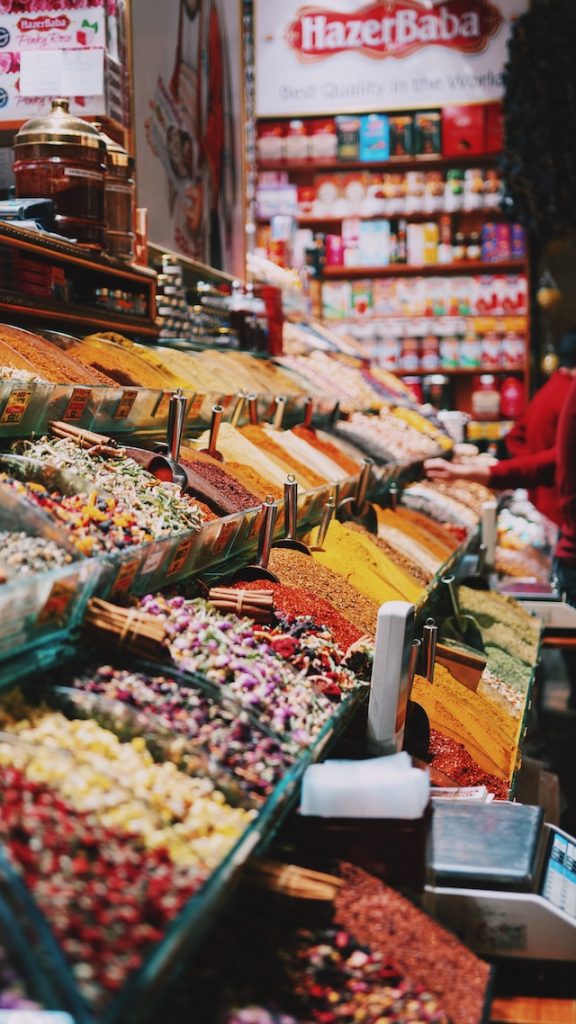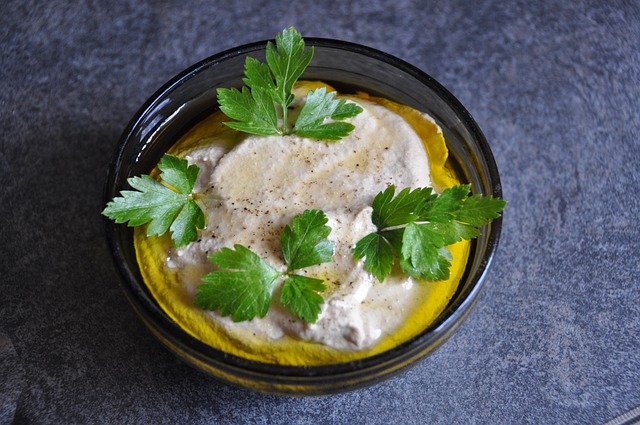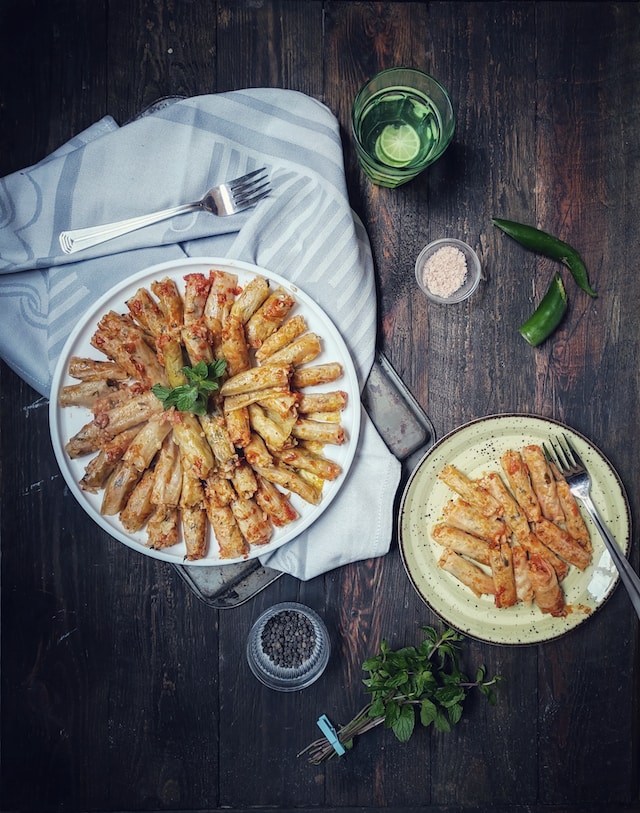
Food in the Middle East is a vibrant mosaic of flavors, colors, and aromas that has captivated gastronomes for centuries. With its distinctive blend of indigenous ingredients, age-old cooking techniques, and diverse cultural influences, Middle Eastern cuisine stands out as a tantalizing tapestry of culinary traditions.
Key Ingredients
Middle Eastern cuisine is renowned for its vibrant and aromatic flavors. At the heart of these tantalizing dishes lie a few key ingredients that define the region’s culinary identity. From grains and vegetables to aromatic herbs and spices, each component plays a crucial role in creating the distinctive tastes of Middle Eastern cuisine.
Grains
Grains form the foundation of many Middle Eastern dishes, providing nourishment and a satisfying base. Wheat, barley, rice, and couscous are commonly used grains in the region. Whether it’s the fluffy pilaf rice accompanying a tender kebab or the hearty tabbouleh salad with bulgur wheat, grains add texture and substance to Middle Eastern cuisine.
Vegetables
Fresh vegetables are a cornerstone of Middle Eastern cooking, adding both color and flavor to dishes. Tomatoes, cucumbers, eggplants, and bell peppers are widely used, while leafy greens such as parsley, mint, and cilantro lend a refreshing touch. Vegetables are often grilled, roasted, or stewed to enhance their natural sweetness and showcase their unique characteristics.
Legumes
Legumes are a vital source of protein in Middle Eastern cuisine and are often used in vegetarian and vegan dishes. Chickpeas, lentils, and fava beans are prominently featured, whether in the form of hummus, falafel, or hearty lentil soups. These legumes contribute richness and depth to the flavor profile of Middle Eastern dishes.
Aromatic Herbs and Spices
The Middle East is renowned for its exquisite blend of aromatic herbs and spices, which infuse dishes with unforgettable aromas and tastes. Cumin, coriander, turmeric, and sumac are just a few examples of the spices that add warmth and complexity to Middle Eastern cuisine. Herbs like za’atar, a blend of thyme, sumac, and sesame seeds, offer a fragrant and citrusy note to dishes.
Olive Oil
Olive oil, a staple ingredient in the Middle East, is used liberally in cooking and as a finishing touch. With its distinct flavor and health benefits, olive oil adds richness and a smooth texture to dishes. Whether it’s drizzled over salads, used to sauté vegetables, or incorporated into dressings and marinades, olive oil elevates Middle Eastern cuisine to new heights.
Arabian Peninsula Cuisine

The Arabian Peninsula, with its vast landscapes and rich cultural heritage, boasts a cuisine that is as diverse as its people. From fragrant spices to succulent meats, Arabian Peninsula cuisine offers a tantalizing medley of flavors and a glimpse into the region’s culinary traditions. Influenced by centuries of trade and exchange, Arabian Peninsula cuisine reflects a blend of indigenous ingredients and international influences. In this section, we will explore the key elements of Arabian Peninsula cuisine, from staple ingredients to iconic dishes.
Staple Ingredients
- Grains: Grains form the backbone of Arabian Peninsula cuisine, providing sustenance and a hearty base for many dishes. Staple grains like rice, wheat, and barley are commonly used, often cooked to perfection and flavored with aromatic herbs and spices.
- Dates: A symbol of hospitality and abundance, dates hold a significant place in Arabian Peninsula cuisine. These sweet, caramel-like fruits are not only enjoyed on their own but also incorporated into savory dishes, desserts, and various beverages.
- Camel Meat: The Arabian Peninsula is known for its unique use of camel meat in traditional dishes. Camel meat is lean and flavorful, and it lends an exotic touch to stews, kebabs, and grilled dishes. Local communities have perfected the art of camel meat preparation, ensuring its tenderness and succulence.
Iconic Dishes
Mandi: A popular dish in the Arabian Peninsula, Mandi is a flavorful rice and meat dish cooked to perfection in an underground clay oven. Tender, marinated meat (often lamb, chicken, or camel) is slow-cooked with fragrant spices, then served over a bed of moist, spiced rice. This aromatic dish is a true feast for the senses.
Kabsa: Another beloved Arabian Peninsula dish, Kabsa is a rice-based delight that combines succulent meat (usually chicken or lamb) with an abundance of aromatic spices. The rice is cooked in a flavorful broth infused with cloves, cardamom, and cinnamon, resulting in a dish with a fragrant and irresistible aroma.
Shawarma: A street food favorite across the Arabian Peninsula, Shawarma is a mouthwatering combination of marinated meat (commonly chicken or beef) and an array of vegetables, all wrapped in a warm, fluffy flatbread. The meat is slow-roasted on a vertical spit, creating tender slices that are bursting with flavor.

Arabian Peninsula cuisine is a reflection of the region’s historical connections and cultural exchange with neighboring countries and distant lands. With its location at the crossroads of ancient trade routes, the Arabian Peninsula has absorbed culinary influences from East and West, resulting in a diverse and dynamic cuisine.
Levantine Delights
With its rich history, Levantine cuisine delights in bringing together flavors, techniques, and ingredients from various cultures and civilizations. From the sun-kissed shores of Lebanon to the bustling markets of Syria, join us as we uncover the captivating world of Levantine gastronomy.
The Levant region is known for its harmonious combination of bold and delicate flavors, creating a tapestry of tastes that dance on the palate. Here, the emphasis is placed on fresh, seasonal ingredients that celebrate the natural bounty of the land and sea.
Mezze: The Art of Small Bites:
A hallmark of Levantine cuisine is the mezze, a collection of small, flavorful dishes that are meant to be shared with friends and family. From creamy hummus to tangy tabbouleh, the mezze spread is a mosaic of colors and flavors that invites you to indulge in an array of tastes.
- Hummus: Silky and smooth, hummus is a staple in Levantine cuisine. Made from pureed chickpeas, tahini, garlic, and lemon juice, this creamy dip is often served with warm bread and drizzled with olive oil.
- Tabouli: Bursting with freshness, tabbouleh is a parsley-based salad that features bulgur wheat, tomatoes, cucumbers, mint, and lemon juice. Its vibrant flavors and invigorating crunch make it a refreshing addition to any Levantine meal.
Baba Ganoush: A smoky and velvety eggplant dip, baba ganoush is made by charring eggplants over an open flame and combining their flesh with tahini, garlic, lemon juice, and spices. The result is a captivating blend of flavors that pairs perfectly with pita bread.

Main Courses
Levantine cuisine showcases a remarkable repertoire of main courses that highlight the region’s abundance of fresh seafood and tender meats.
Shawarma: Delicately spiced and marinated strips of meat (typically lamb, beef, or chicken) are slow-roasted on a rotating vertical spit until they are succulent and tender. Served in a warm pita bread and garnished with pickles, tomatoes, and a drizzle of tahini sauce, shawarma is a street food favorite that satisfies cravings with every bite.
Kofta: Ground meat, often lamb or beef, is seasoned with aromatic spices, herbs, and onions, then shaped into skewers or patties before being grilled to perfection. These juicy and flavorful morsels are delicious on their own or served with rice and grilled vegetables.
Grilled Fish: With its proximity to the Mediterranean Sea, the Levant region is blessed with an abundance of fresh fish and seafood. Whether it’s whole grilled sea bass, succulent shrimp kebabs, or pan-seared red snapper, Levantine cuisine celebrates the delicate flavors of the sea.
Sweet Delights
No journey through Levantine cuisine would be complete without indulging in its array of sweet treats that tempt the senses and capture the essence of its culinary heritage.
- Baklava: Layers of flaky phyllo pastry, crunchy nuts (typically pistachios or walnuts), and luscious honey syrup create a symphony of textures and flavors. Each bite of baklava is a decadent experience that showcases the Levant’s mastery of pastry making.
- Kanafeh: This luscious dessert features a layer of shredded pastry, a creamy filling of sweet cheese, and a generous drizzle of fragrant sugar syrup. Baked until golden and crispy, kanafeh offers a delightful interplay of textures and a hint of floral flavor.
- Turkish Delight: Known as lokum in the Levant, Turkish delight is a gelatinous sweet treat made with starch, sugar, and a variety of flavors and fillings such as pistachios, rosewater, or citrus. These bite-sized delights are often dusted with powdered sugar and are perfect for savoring alongside a cup of Turkish coffee.
Persian Cuisine: A Culinary Journey Through Ancient Persia
Rooted in rich cultural heritage and influenced by diverse regional ingredients, Persian cuisine is a tapestry of aromatic flavors, intricate preparation techniques, and a celebration of the bountiful offerings of the land.
Flavors of Persia

At the heart of Persian cuisine lies a harmonious blend of flavors that captivate the senses and leave a lasting impression. The delicate balance of sweet and sour, the infusion of aromatic herbs and spices, and the heavy reliance on fresh ingredients form the foundation of Persian culinary traditions.
Rice
Rice, commonly known as “polo” in Persian, takes center stage in Persian cuisine and stands as a symbol of hospitality and abundance. From fluffy, saffron-infused basmati rice to jeweled rice adorned with vibrant fruits and nuts, the art of rice cooking is perfected in Iran. Each grain is meticulously steamed to achieve a light and airy texture, creating a fragrant canvas for other Persian delights.
Tahdig
One cannot speak of Persian cuisine without mentioning tahdig, the coveted golden crust that forms at the bottom of the rice pot. This crisp and flavorful layer, achieved through a careful combination of heat and technique, is a culinary masterpiece in its own right. Whether it’s the savory tahdig made with saffron and potatoes or the sweet tahdig adorned with caramelized sugar and pistachios, this prized delicacy adds depth and complexity to any Persian meal.
Herbs and Spices
Persian cuisine owes its vibrant flavors to an exquisite blend of herbs and spices that elevate each dish to new heights. Saffron, the world’s most precious spice, adds a luxurious touch with its distinct aroma and golden hue. Turmeric, cinnamon, cardamom, and cumin infuse Persian dishes with warmth and depth, while fresh herbs like mint, parsley, and dill lend a refreshing and aromatic note to the cuisine.
Stews
No exploration of Persian cuisine would be complete without delving into the world of Persian stews, or “khoresht.” These hearty and comforting dishes combine tender meats or vegetables with an array of aromatic spices, herbs, and fruits. From the iconic lamb and split pea stew known as “ghormeh sabzi” to the sweet and tangy chicken and pomegranate stew called “fesenjan,” each khoresht is a testament to the meticulous cooking techniques and rich culinary heritage of Iran.
Desserts
Persian desserts are a stunning display of culinary craftsmanship, with their delicate presentation, intricate flavors, and irresistible sweetness. Rosewater, saffron, and pistachios take center stage, while honey, dates, and cardamom add a hint of natural sweetness. From the elegant and aromatic rosewater-scented rice pudding known as “sholeh zard” to the divine saffron and almond brittle called “sohan,” Persian desserts are a true indulgence for the senses.

Egyptian Cuisine
The lands of pharaohs and pyramids hold some hidden treasures. With a history that stretches back to ancient times, Egyptian cuisine is a testament to the rich cultural heritage and diverse influences that have shaped this culinary tradition. From the vibrant spices to the hearty street food, prepare to be immersed in the flavors of Egypt.
Egyptian cuisine is a mosaic of flavors that showcases the region’s agricultural abundance and the ingenuity of its people. Influenced by ancient Egyptian, Arab, Ottoman, and Mediterranean cultures, the flavors of Egypt are a fusion of aromatic spices, fresh herbs, and quality local produce.
The Lifeline of Egyptian Gastronomy
The Nile River’s gift of fertile soil has bestowed Egypt with an abundance of staple ingredients that form the basis of its cuisine. From the ancient grain, “kamut,” to the beloved Egyptian rice, the Nile’s offerings provide sustenance and nourishment for the people of Egypt.
Ful Medames
Start your day the Egyptian way with a bowl of ful medames. This hearty dish consists of slow-cooked fava beans infused with garlic, lemon juice, and aromatic spices. Topped with olive oil, tahini, and fresh vegetables, biting into a warm, freshly baked Egyptian bread alongside it is an experience that transports you to the bustling streets of Cairo.
Koshary
Koshary is the epitome of Egyptian street food—a comforting and satisfying dish that brings together the best of both worlds. Layers of rice, lentils, macaroni, and chickpeas are topped with a tangy tomato sauce and garnished with crispy fried onions. This humble yet flavorful medley is a testament to Egypt’s culinary prowess.
Mahshi
Mahshi, meaning “stuffed,” is a traditional Egyptian dish that showcases the art of filling vegetables with a variety of ingredients. From vine leaves filled with rice and herbs to bell peppers stuffed with spiced minced meat, these delectable parcels are cooked until tender and bursting with flavor.
Egyptian Sweet Delights
Egyptian desserts are a celebration of sweetness and indulgence, often featuring luscious combinations of nuts, honey, and aromatic spices. Sink your teeth into the flaky layers of baklava, delight in the nutty richness of basbousa, or savor the decadence of “um ali,” a warm bread pudding infused with nuts and raisins soaked in sweetened milk. Each bite is a testament to Egypt’s love for dessert.
Egyptian Tea and Qahwa

No Egyptian culinary experience is complete without indulging in a cup of traditional tea or qahwa. Egyptian tea, black tea steeped with aromatic spices like cinnamon and cardamom, is a comforting and familiar beverage. Qahwa, a fragrant and herbal coffee infused with cardamom, is the ideal drink for those seeking a caffeine boost.
Whether you find yourself at a bustling food market in Beirut, a trendy falafel joint in Tel Aviv, or a cozy Middle Eastern restaurant in London, each bite of Middle Eastern cuisine promises an exploration of centuries-old traditions, a celebration of culinary craftsmanship, and an invitation to savor the true essence of this captivating region.
